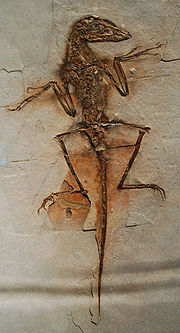
NGMC 91
Encyclopedia

Dromaeosauridae
Dromaeosauridae is a family of bird-like theropod dinosaurs. They were small- to medium-sized feathered carnivores that flourished in the Cretaceous Period. The name Dromaeosauridae means 'running lizards', from Greek dromeus meaning 'runner' and sauros meaning 'lizard'...
dinosaur from the Early Cretaceous
Early Cretaceous
The Early Cretaceous or the Lower Cretaceous , is the earlier or lower of the two major divisions of the Cretaceous...
Yixian Formation
Yixian Formation
The Yixian Formation is a geological formation in Jinzhou, Liaoning, People's Republic of China, that spans 11 million years during the early Cretaceous period...
of Liaoning
Liaoning
' is a province of the People's Republic of China, located in the northeast of the country. Its one-character abbreviation is "辽" , a name taken from the Liao River that flows through the province. "Níng" means "peace"...
, China
China
Chinese civilization may refer to:* China for more general discussion of the country.* Chinese culture* Greater China, the transnational community of ethnic Chinese.* History of China* Sinosphere, the area historically affected by Chinese culture...
. The specimen is in the collection of the National Geological Museum of China. It was collected in Fanzhangzi quarry, near Lingyuan City, Liaoning Province. This location is part of the Dawangzhangzi fossil beds, which have been dated to about 122 million years ago, during the early Aptian
Aptian
The Aptian is an age in the geologic timescale or a stage in the stratigraphic column. It is a subdivision of the Early or Lower Cretaceous epoch or series and encompasses the time from 125.0 ± 1.0 Ma to 112.0 ± 1.0 Ma , approximately...
age. A specimen of the fish Lycoptera
Lycoptera
Lycoptera is a genus of fish that lived from the late Jurassic to Cretaceous periods in present-day China, Korea, Mongolia and Siberia. It is known from abundant fossils representing sixteen species, and is an important index fossil used to date geologic formations in China...
is also preserved near the foot.
Feathers
NGMC 91 is notable for its extensive preservation of various types of featherFeather
Feathers are one of the epidermal growths that form the distinctive outer covering, or plumage, on birds and some non-avian theropod dinosaurs. They are considered the most complex integumentary structures found in vertebrates, and indeed a premier example of a complex evolutionary novelty. They...
s. First, several filaments were joined together into "tufts", like the structure of down feather
Down feather
The down of birds is a layer of fine feathers found under the tougher exterior feathers. Very young birds are clad only in down. Powder down is a specialized type of down found only in a few groups of birds. Down is a fine thermal insulator and padding, used in goods such as jackets, bedding,...
. Second, a row of filaments (barbs) were joined together to a main shaft (rachis), making them similar in structure to normal bird
Bird
Birds are feathered, winged, bipedal, endothermic , egg-laying, vertebrate animals. Around 10,000 living species and 188 families makes them the most speciose class of tetrapod vertebrates. They inhabit ecosystems across the globe, from the Arctic to the Antarctic. Extant birds range in size from...
feathers. While they do not preserve the tiny hooks (barbules) that modern feathers have, which allow the feathers of modern birds to form a discrete vane, discrete vanes are visible in the feathers of the forelimbs, hindlimbs and tail, suggesting that barbules must have been present in life. The feathers covered the entire body, including the head in front of the eye, the neck, wing-like sprays on the arms, long feathers on the thighs, and a lozenge-shaped fan on the tail like that of Archaeopteryx
Archaeopteryx
Archaeopteryx , sometimes referred to by its German name Urvogel , is a genus of theropod dinosaur that is closely related to birds. The name derives from the Ancient Greek meaning "ancient", and , meaning "feather" or "wing"...
.
Classification
NGMC 91 was first described in a paper published in the journal Nature by Ji Qiang and colleagues in 20012001 in paleontology
-Newly named insects:-Newly named bony fishes:-Newly named amphibians:-Newly named turtles:-Ichthyosaurs:-Newly named basal lepidosauromorphs:-Newly named plesiosaurs:-Newly named sphenodonts:-Newly named basal archosauromorphs:...
. They declined to name the specimen because, although the specimen is completely articulated, almost all of the bones shattered when the fossil slabs were split, so that only the silhouettes of theses bones are clear in most of the part and counterpart. This obscured diagnostic skeletal features, which made the specimen's genus uncertain. They noted that it was similar in some respects to Sinornithosaurus millenii, and they suggested that the differences between the two could have been due to age. Ji, along with another team of scientists, further emphasized this similarity in a 2002 paper, in which they formally referred the specimen to Sinornithosaurus, though they considered the exact species questionable. Meanwhile, Stephen Czerkas and colleagues considered the specimen to represent an example of their newly described species Cryptovolans pauli (now usually considered a synonym of Microraptor gui), based on supposed wing proportions.
Phylogenetic studies did not support the idea that NGMC 91 was a close relative of S. millenii. In a 2004 analysis, Phil Senter and colleagues found that it was, in fact, more closely related to Microraptor. Subsequent studies, also by Senter, have continued to show support for this finding despite the fact that some data used in the original study was later found to be flawed.

